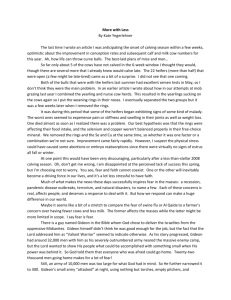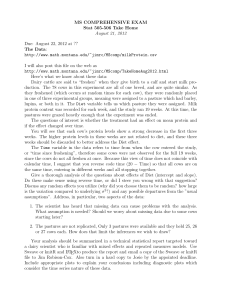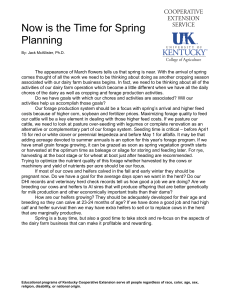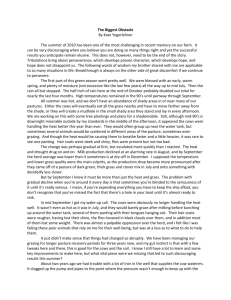P Pasture for Dairy Cattle: Challenges and Opportunities
advertisement
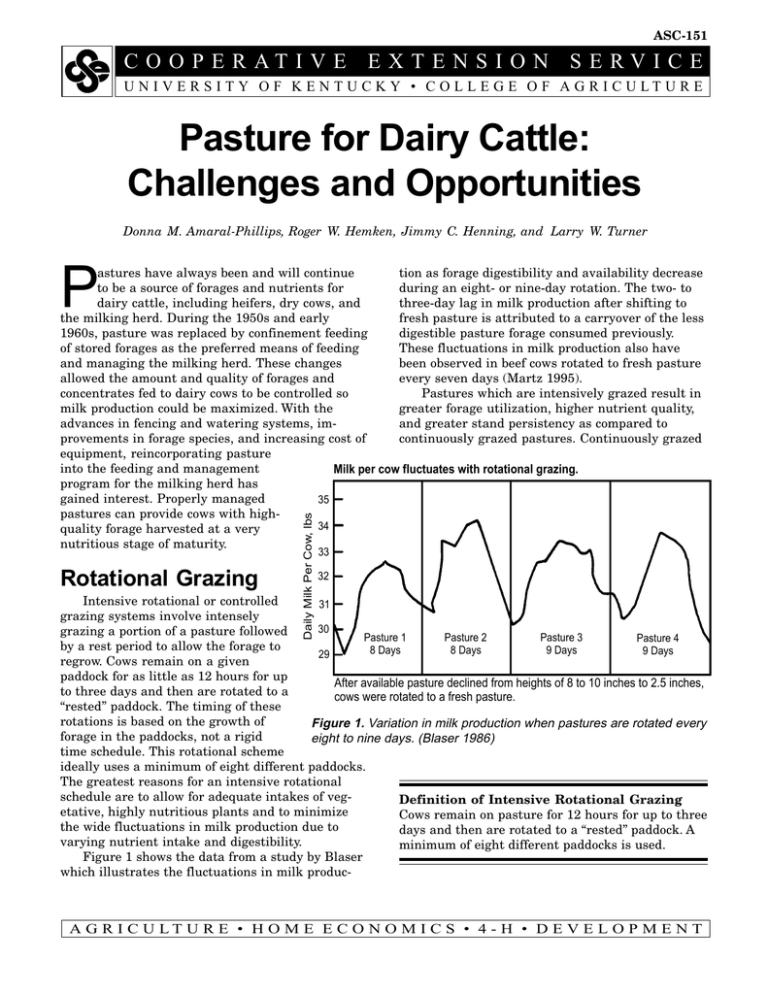
ASC-151 C O O P E R AT I V E EXTENSION SERVICE U N I V E R S I T Y O F K E N T U C K Y • C O L L E G E O F A G R I C U LT U R E Pasture for Dairy Cattle: Challenges and Opportunities Donna M. Amaral-Phillips, Roger W. Hemken, Jimmy C. Henning, and Larry W. Turner P Rotational Grazing Daily Milk Per Cow, lbs astures have always been and will continue tion as forage digestibility and availability decrease to be a source of forages and nutrients for during an eight- or nine-day rotation. The two- to dairy cattle, including heifers, dry cows, and three-day lag in milk production after shifting to the milking herd. During the 1950s and early fresh pasture is attributed to a carryover of the less 1960s, pasture was replaced by confinement feeding digestible pasture forage consumed previously. of stored forages as the preferred means of feeding These fluctuations in milk production also have and managing the milking herd. These changes been observed in beef cows rotated to fresh pasture allowed the amount and quality of forages and every seven days (Martz 1995). concentrates fed to dairy cows to be controlled so Pastures which are intensively grazed result in milk production could be maximized. With the greater forage utilization, higher nutrient quality, and greater stand persistency as compared to advances in fencing and watering systems, improvements in forage species, and increasing cost of continuously grazed pastures. Continuously grazed equipment, reincorporating pasture into the feeding and management Milk per cow fluctuates with rotational grazing. program for the milking herd has gained interest. Properly managed 35 pastures can provide cows with high34 quality forage harvested at a very nutritious stage of maturity. 33 32 Intensive rotational or controlled 31 grazing systems involve intensely 30 grazing a portion of a pasture followed Pasture 2 Pasture 3 Pasture 1 Pasture 4 by a rest period to allow the forage to 8 Days 9 Days 8 Days 9 Days 29 regrow. Cows remain on a given paddock for as little as 12 hours for up After available pasture declined from heights of 8 to 10 inches to 2.5 inches, to three days and then are rotated to a cows were rotated to a fresh pasture. “rested” paddock. The timing of these rotations is based on the growth of Figure 1. Variation in milk production when pastures are rotated every forage in the paddocks, not a rigid eight to nine days. (Blaser 1986) time schedule. This rotational scheme ideally uses a minimum of eight different paddocks. The greatest reasons for an intensive rotational schedule are to allow for adequate intakes of vegDefinition of Intensive Rotational Grazing etative, highly nutritious plants and to minimize Cows remain on pasture for 12 hours for up to three the wide fluctuations in milk production due to days and then are rotated to a “rested” paddock. A varying nutrient intake and digestibility. minimum of eight different paddocks is used. Figure 1 shows the data from a study by Blaser which illustrates the fluctuations in milk produc- A G R I C U LT U R E • H O M E E C O N O M I C S • 4 - H • D E V E L O P M E N T ing forage quality, decreasing harvesting costs, and/ or increasing the utilization of land close to the barn which is not well-suited for harvesting forages due to its excessive slope. When pasture is plentiful during the spring, it can supply a larger proportion of the forages fed, and when pasture availability decreases in midsummer, the amount of stored forages can be increased to ensure that cows maintain their feed (dry matter) intakes. A supplemental grazing system is an excellent way to learn how to manage the interrelationships between forages and cattle before relying on pasture as the sole forage source during the grazing season. A leader-follower scheme within a rotational grazing system can be an effective means of meeting the greater nutrient needs of early lactation and higher-producing cows (Figure 2). In this scheme, cows or heifers with the highest nutrient requirements are allowed to graze first and allowed to eat the tops and the most nutritious part of the plants. A second group of cows or heifers with lower nutrient requirements then is allowed to graze the paddock and remove the remaining forage to the desired height before being moved. This scheme allows the allocation of the forages with the highest nutrients to cows or heifers with the highest demand for nutrients without sacrificing growth or milk production. pastures contain some areas where forage regrowth is being grazed too closely and other areas that are overgrown with over-mature, low-quality forage that is not being consumed. Studies in Florida with Callie bermudagrass (Mathews et al. 1994) show that leaves made up 46 percent to 49 percent of the stand when rotational grazed compared to 31 percent to 36 percent when the stand was continuously grazed by dairy heifers. With more leaves in the stand, a more nutritious forage was available for grazing. In addition, the rotational-grazed stand had 84 percent Callie bermudagrass remaining after two years versus 62 percent under continuous grazing by dairy heifers. Grazing Schemes Grazing Systems for Dairy Cows (April through November) • • All forage provided by pastures Supplemental grazing where 25 percent to 75 percent of forage needs are supplied through grazing depending on forage availability. Grazing can supply 25 percent to 100 percent of the forage needs of a high-producing dairy cow between April and November in Kentucky. Traditionally, pasture systems provided all of the forage consumed with or without a limited amount of hay being fed. Grain, then, is supplied either through the parlor, outside in feed troughs, or on the ground as a large range pellet. Supplemental grazing systems, where grazed forages represent only 25 percent to 75 percent of the forage dry matter intake, also can be an economical and viable option for using pasture. Supplemental pasture is used in combination with harvested silages and/or hay as a means of improv- Pasture No. 1 2 3 Grazing Behavior of Cows Cows graze by wrapping their tongues around the forage and snipping it off with their lower teeth and upper dental pad. (Cattle do not have upper teeth.) They are very selective in their grazing habits, first choosing tender young plants which are easily eaten and most palatable. In addition, cows eat the top of the plant first, consuming leaves before stems. Figure 3 illustrates the effect of the number of grazing days on crude protein content of 4 5 6 7 First Grazers Last Grazers Sequence of Grazing Pastures Figure 2. Diagram of available pasture when feeding first and last grazers in rotational grazing. (Blaser 1986) 2 inches. In addition, the lower stem is lower in crude protein and relative feed value than the stem found in the upper 6 inches of the alfalfa plant. These changes in nutrient content need to be considered when planning a nutrition program around an intensive rotational grazing program. The “new grazing” varieties of alfalfa are being bred to have more leaves on the stem and to grow closer to the ground. In the future these varieties may help decrease this selective grazing. Pasture intake is related to the amount of time spent grazing, the number of bites per minute, and the size of each bite (Phillips et al. 1988). Dairy cattle generally graze for six to nine hours per day. Because of a cow’s need to ruminate and rest, she seldom grazes over nine hours per day. The number Figure 3. Crude protein content of alfalfa/grass of bites taken per minute does not vary appreciably, pastures when placed in a 12-paddock rotation. ranging from 55 to 65 bites per minute. Thus, dry (Morrow 1995) matter intake from pasture is controlled by the size of the bite of forage. This is directly related to the height and density of the forage stand being grazed. remaining alfalfa/grass plants. The crude protein In Scotland, Phillip and Leaver (1989) meacontent of alfalfa decreases dramatically within the sured forage intake of cows grazing ryegrass pasfirst day of the 12-paddock, three-day rotation as ture in the spring when grass was very lush and the leaves at the top of the alfalfa plant are conagain in the fall when pasture growth was lower. In sumed first. the spring, when forage growth was at its maximum, Table 1. Distribution of leaf, stem, and total dry matter in a summer alfalfa cows averaged 60 bites per canopy. Nutrient content of leaf and stem areas is listed on a dry matter minute over an eight-hour basis. grazing period and were able NDF to consume 31.7 pounds of dry matter daily (0.50 grams % of CP ADF Digestibility of dry matter per bite). In the Total Yield (%) (%) RFV (%) fall, cows averaged 65 bites Upper 6 inches of plant 37.3 per minute and grazed for Leaf 30.8 24.0 18.5 250 63.2 nine hours a day but were Stem 6.5 13.0 38.6 104 44.0 able to consume only 19.6 pounds of dry matter daily Lower 12 inches of plant 62.7 (0.25 grams of dry matter per Leaf 12.9 22.0 16.6 273 65.7 bite). These data illustrate Stem 49.8 9.6 52.9 65 31.1 the importance of forage CP=crude protein content, ADF=acid detergent fiber, RFV=relative feed value, density and height when NDF=neutral detergent fiber trying to maximize intake of (Adapted from Henning 1996) dairy cows grazing pasture. Cows generally prefer to graze during the early The distribution of leaf and stem area differs and late daylight hours. During the hottest months, between well-managed grass pastures and those cows will not graze during the late morning and containing legumes. In well-managed grass pasafternoon hours and may compensate slightly by tures kept in the vegetative state, the plant is increasing the time spent grazing during the night. primarily leaf area evenly distributed throughout Changes in milking times and management may be the height of the plant with a similar nutrient beneficial in allowing cows to graze during the early content found throughout the canopy. However, morning hours and later in the evening after the with alfalfa and red clover pastures, the top part of sun has gone down. the plant contains a higher percentage of leaf area. As shown in Table 1, more than 80 percent of the top 6 inches of the alfalfa plant is leaf, whereas 80 percent of the stem is found in the bottom 12 3 Pasture Intake and Quality Govern Milk Production Keys to Profitable Milk Production Using Pasture 1. Amount of forage available 2. Intake of pasture 3. Nutritional quality of pasture 4. Supplemental concentrates fed 5. Supplemental forages fed when pasture intake limiting The availability and quality of pasture forage consumed directly influence milk production. When forage availability decreases, the bite size of pasture forage decreases. Consequently, milk production decreases. Forage availability in pasture needs to be maintained to allow cows to milk to their genetic potential. Table 2 shows the estimated carrying capacity of pastures when pasture supplies all of the forage needs of Holstein dairy cows. Figure 4 shows a sample calculation for determining the number of cows which can graze an acre of forage daily. Lactating dairy cows will have dry matter intakes of pasture between 1.5 percent and 3.0 percent of body weight depending on the availability of pasture, amount of supplemental concentrates provided, and milk production and stage of lactation of the cows. Holden and others (1994) reported that mature, midlactation Holstein cows averaging 68 pounds of milk consumed approximately 32 pounds of dry matter per day as pasture in the spring, or approximately 2.5 percent of their body weight. The authors noted that average daily pasture dry matter intake was the highest in late spring and fall and lowest during the summer. Intakes of pasture may exceed those observed with harvested forages due to greater turnover rates in the rumen. Pasture forages generally are more nutritious than stored forages because cows harvest them at a more immature stage of growth. Table 3 shows the nutritive content of rotationally grazed pastures versus hay and silages raised in the Northeast and Midwest. Table 4 shows the average nutrient composition of pastures composed of grass, grass/ legume, or legume/grass. Well-managed pastures provide enough energy and protein for Holsteins producing 35 pounds to 45 pounds of milk with little or no additional supplementation. Early lactation and higher-producing cows need additional grain to meet their energy needs for production and reproduction. Bernard (1994) calculated the effect of decreasing pasture Table 2. Estimated carrying capacity of pastures where pasture supplies all of forage needs for Holstein dairy cows. Actual carrying capacity will vary based on varying forage yields and utilization rates. Month Mar Apr May June July Aug Sept Oct Wheat—Grazed in Spring (Annual yield—2 tons DM/acre with a 60% utilization rate. Assumes 30% yield from November to February, which has not been included here.) Monthly distribution of yield (%) 10 25 35 Monthly yield (ton DM/acre) 0.2 0.5 0.7 Number cows support/acre/day 6 15 21 Number acres for 100 cows/day 16.7 6.7 4.8 Cool Season Grass/Clover (Annual yield—4 tons DM/acre with Monthly distribution of yield (%) 15 20 Monthly yield (ton DM/acre) 0.6 0.8 Number cows support/acre/day 18 25 Number acres for 100 cows/day 5.6 4.0 60% utilization rate.) 20 10 5 0.8 0.4 0.2 25 12 6 4.0 8.3 16.7 Alfalfa/Grass (Annual yield—5 tons DM/acre with 65% utilization rate.) Monthly distribution of yield (%) 25 20 15 15 Monthly yield (ton DM/acre) 1.25 1.00 0.75 0.75 Number cows support/acre/day 42 33 25 25 Number acres for 100 cows/day 2.4 3.0 4.0 4.0 Sorghum/Sudan Grass (Annual yield—6 tons DM/acre with 65% utilization rate.) Monthly distribution of yield (%) 5 20 30 Monthly yield (ton DM/acre) 0.3 1.2 1.8 Number cows support/acre/day 10 40 60 Number acres for 100 cows/day 10.0 2.5 1.7 10 0.4 12 8.3 10 0.50 17 5.9 10 0.50 17 5.9 20 1.2 40 2.5 15 0.9 30 3.3 10 0.4 12 8.3 5 0.3 10 10.0 Assumptions: Holstein cows consume pasture as the sole forage source at 3% body weight, cows are rotated to new pasture daily, and cows do not regraze the pasture for 30 days. Monthly distribution of pasture yields based on numbers found in KY Beef. For Jersey cows, increase daily carrying capacity by 40% more cows per acre. 4 To calculate the number of cows an acre of pasture can support: Step 1: Calculate amount of pasture needed daily by each cow. Example: Holsteins averaging 1,300 lb body weight. These cows consume forage dry matter at 3% of their body weight with 60% utilization of forage stand. (1,300 lb BW) x (0.03) = 39 lb dry matter/cow ÷ 60% utilization of forage stand = need 65 lb dry matter/cow/day Step 2: Calculate amount of forage supplied monthly by an acre of pasture, assuming cows graze this acre only once each month that forage is available. Example: Wheat grazed in the month of April. Monthly forage tonnage figures supplied in Table 2. For wheat grazed in April, 25% of 2 tons dry matter/acre total yield (0.25) (2 tons dry matter/acre) = 0.5 tons dry matter/acre = 1,000 lb dry matter/acre Step 3: Calculate number of cows an acre of pasture can support. Results from Step 2 = number of cows per acre Results from Step 1 Example: 1,000 lb dry matter = 15 cows/acre 65 lb dry matter/cow Figure 4. Calculations for the number of cows an acre of pasture can support. Table 3. Nutrition content of rotational-grazed pastures compared to hay and silages. Crude Protein NEL NSC** ADF NDF (%) (Mcal/lb) (%) (%) (%) ---------------------Dry Matter Basis----------------------Mixed, mostly grass Pasture Hay Silage Corn silage Recommended total diet requirements for a herd averaging 60 lb milk 22* 12 14 0.69 0.54 0.51 16 18 13 27 38 41 48 60 58 9 0.73 34 26 45 16 0.76 35 19 28 *Averaged 24% CP soluble and 72% CP rumen degradabilty (DIP) **NSC=Nonstructural carbohydrates (Rayburn and Fox 1991) 5 Table 4. Average nutrient composition of typical high-quality pastures in Northeast and Midwest. Grass pasturea CP (% of DM) Sol. P. (% of CP)d DIP (% of CP)e UIP (% of CP)f ADF (% of DM) NDF (% of DM) NSC (% of DM) NEL (Mcal/lb.) Ca (% of DM) P (% of DM) Mg (% of DM) K (% of DM) Fat (% of DM) Grass/legume pastureb Legume/grass pasturec Spring Summer Fall Spring Summer Fall Spring Summer Fall 20-22 35-40 75-80 20-25 28 45 15-20 .73-.77 .50 .30 .14 3.2 3.0 18-20 30-35 65-70 30-35 33 55 15-20 .65-.68 .50 .30 .17 2.4 3.0 20-22 40 70-75 25-30 28 45 15-20 .70-.74 .50 .30 .20 2.8 4.0 21 35-40 80 20 26 42 15-20 .74-.78 .75 .30 .15 3.3 4.0 21 35-40 65-70 30-35 31 52 15-20 .66-.70 .75 .30 .19 2.5 4.0 23 40 70-75 25-30 26 42 15-20 .71-.75 .75 .30 .21 3.0 4.0 23 40 80 20 25 38 20 .74-.78 1.2 .30 .16 3.4 4.0 23 35 70 30 30 48 25 .68-.72 1.2 .30 .20 2.6 4.0 25 45 75 25 25 38 20 .72-.76 1.2 .30 .22 3.2 4.0 a Grass-based pasture. b Mixed, mostly grass pasture. c Mixed, mostly legume pasture. d Soluble protein. Degradable intake protein. f Undegradable intake protein. (Muller 1994) e Table 5. Pasture intakes necessary to balance energy requirements at different qualities and availabilities of pasture. Milk Grain to Needed pasture intake, lb/da (lb/d) milk Excellent Good Fair Poor Number of grazing periodsb Excellent Good Fair Poor 80 1:3 1:5 1:7 155 232 266 163 244 279 171 257 294 180 271 310 1.7c 2.6 3.0 2.3 3.5 4.0 3.8 5.7 6.5 6.0 9.0 10.3 70 1:3 1:5 1:7 149 217 246 157 229 259 165 241 273 174 253 287 1.7 2.4 2.7 2.2 3.3 3.7 3.7 5.4 6.1 5.8 8.4 9.6 60 1:3 1:5 1:7 144 202 227 151 213 239 160 224 252 168 236 265 1.6 2.2 2.5 2.2 3.0 3.4 3.5 5.0 5.6 5.6 7.9 8.8 50 1:3 1:5 1:7 139 187 208 146 197 219 154 208 231 162 218 242 1.5 2.1 2.3 2.1 2.8 3.1 3.4 4.6 5.1 5.4 7.3 8.1 40 1:3 1:5 1:7 133 172 189 140 181 199 148 191 209 155 201 220 1.5 1.9 2.1 2.0 2.6 2.8 3.3 4.2 4.7 5.2 6.7 7.3 a Pounds of pasture based on 15% DM and NEL concentrations of 0.70 (Excellent), 0.67 (Good), 0.63 (Fair), and 0.60 Mcal/lb (Poor). b Number of two- to three-hour grazing periods based on cows consuming 90 (Excellent), 70 (Good), 45 (Fair), and 30 lb (Poor) of pasture (15% DM) during each grazing period. c Shaded values are considered realistic pasture intakes. (Bernard 1994) 6 mixes of midlactation cows have failed to show a availability on the number of two- to three-hour production response. However, one study using grazing periods necessary to balance energy reearly lactation cows has shown a positive response quirements at different amounts of milk production to the addition of a high UIP protein source. Generand grain-to-milk ratios (Table 5). Bernard assumed ally, concentrate mixes for pasture-based rations that three grazing periods were the maximum contain 12 percent to 14 percent crude protein with number allowable in order for cows to actually added dried distillers’ grains, roasted soybeans, consume the needed forage to meet their energy animal by-products, or other high UIP protein needs. At 80 pounds of milk, excellent quality and sources. In order to effectively utilize the large quantity pasture was necessary to achieve adequate amount of soluble and degradable protein in highpasture intakes. Only with a 1:3 grain-to-milk ratio quality pastures, sufficient energy, supplied by did good quality pasture provide adequate pasture grains such as corn, must be present to optimize intake at 80 pounds of milk. From research conrumen fermentation. Work in Europe has suggested ducted by Holden and others at Penn State, Holthat the addition of high-fiber by-products, such as steins producing more than 60 pounds of milk with soy hulls, may enhance rumen fermentation, milk good quality pasture should be supplemented with 1 production, and butterfat test on pasture-based diets. pound of grain per 4 pounds of milk, with the amount of concentrate varied with milk production and body condition. Table 6. Nutrient content (DM basis) of pasture consumed by cattle with Generally, 12 pounds to 20 esophageal cannulas to collect samples actually consumed. pounds of concentrate are fed CP NDF ADF NSC UIP NEL to cows when pasture is their Pasture or Feed (%) (%) (%) (%) (%, CP) (Mcal/lb) sole forage source. When pastures are fed as the Alfalfa, 10% Blm 34.7 43.5 16.7 11.8 30 0.83 major forage source, energy Alfalfa, prebud 32.7 27.5 22.6 31.8 30 0.75 may not be optimum for effiFescue (Veg)cient microbial growth, which Clover (bloom) 25.0 57.0 29.4 10.0 25 0.66 in turn can limit milk produc(Martz and Garrett 1993) tion. Grass and grass/legume pastures are low in nonstructural carbohydrates (15 percent to 20 percent NSC) compared to the requirements of high-producing dairy cows (35 As with all feed changes, dairy cows, especially percent to 40 percent NSC). Thus, feeding grains can high-producing cows, need to be adjusted to pasture increase the amount of non-structural carbohyslowly. Any sudden changes will result in cows going drates when added to the diet. off feed with an associated rapid decrease in milk Grazing cows also have a 10 percent to 20 production. Ideally, this transition should take place percent higher maintenance requirement because of over at least a week, with cows allowed on pasture the greater activity level associated with grazing. for longer periods of time each successive day. For Ideally, cows should not be pastured farther than example, on day one cows are fed stored forages (for 0.5 mile from the milking facility. However, little example, 5 pounds of hay) before being turned out data exist to show that farther distances will be on pasture and are allowed access to pasture for one detrimental to milk production. Cows which graze hour. Each day, cows are allowed access to the often are thinner in body condition in comparison to pasture for longer periods of time. Hungry cows cows fed in confinement. Thus, body condition in should not be allowed access to pasture. addition to milk production needs to be considered Bloat can occur when grazing legumes such as when determining the amount of supplemental clover and alfalfa. Generally, bloat occurs within an concentrate needed. hour of being placed on pasture and is more prevaWith proper grazing management, pasture is lent the second or third day of grazing. Five pounds very high in total crude protein, averaging 20 of dry hay prior to grazing can help reduce the probpercent or more. Samples of consumed pasture lem. Poloxalene (Bloat Guard), a commercial surfac(from esophageal-cannulated steers) suggest cows tant, can be added to the grain, mineral premix, or may consume even higher concentrations of protein water. It is very effective in preventing bloat in cows. and energy, which reflects their selective grazing Off flavors in milk can be a problem when (Table 6). However, 65 percent to 80 percent of the grazing annual rye, some alfalfas, and weeds such protein in high-quality pasture is degraded in the as wild onions or ragweed. Removing cows from the rumen (DIP). This concentration of DIP is higher pasture two to four hours prior to milking will help than that recommended by the NRC (60 percent to prevent off flavors in the milk. 65 percent) and may suggest that additional UIP (bypass protein) sources would be beneficial. Studies where a UIP source has been added to the grain Adapt Cows to Pasture Slowly 7 to 0.30 percent magnesium. The addition of magnesium oxide as a buffer at the rate of 0.05 to 0.10 pounds per cow per day will provide adequate supplemental magnesium. Bottom Line Figure 5. Schematic of a portable shade. Plan # KY.II.772-16 provides detailed instructions for building a portable shade. Contact the Department of Agricultural Engineering at the University of Kentucky to obtain a copy. Shade and Water In each paddock, shade and water should be provided unless cows are supplementally grazing for less than one hour in the summer and two hours in the spring. Portable shades can be moved as pastures are rotated, decreasing the chances of environmental mastitis. (A schematic of a portable shade is shown in Figure 5.) Grazing in the early morning and late evening will decrease the need for shades. Lactating dairy cows consume an enormous amount of water. Table 7 shows the estimated water intake at various temperatures. Water should be located within 600 feet of the available pasture for better manure distribution and better pasture consumption. Table 7. Estimated water needs for lactating and dry dairy cows at various temperatures. --------------Temperature-------------Milk 10-40°F 70°F 90°F Production ------------------gal/day-----------------Dry Cow 40 lb milk 80 lb milk 6.0 16.0 26.0 8.7 21.5 34.3 8.7 26.5 44.9 Mineral Supplementing of Cows on Pasture Minerals and vitamins for milking cows on pasture should be force-fed through inclusion in the concentrate mixture. Usually, calcium, phosphorus, magnesium, trace minerals, and vitamins are added to the grain mixture. Lush-growing pastures are high in potassium and low in magnesium, which can result in a magnesium deficiency (grass tetany). Rations using pasture should contain 0.25 percent Well-managed pastures can provide highquality and economical forages to lactating dairy cows. The key to making a grazing system work is providing the cow with a readily available pasture which does not limit forage intake and to maintain the pasture in a vegetative state to provide a highly nutritious forage. Concentrates should be fed to optimize milk production on pastures and complement the nutrients supplied by these forages. References Bernard, John K. 1994. New developments in dairy cattle grazing. Tennessee Dairy Schools. Blaser, R.E. et al. 1986. Forage—Animal Management Systems. VPI Bulletin 86-7. Gerrish, J.R. and C. Roberts (editors). 1995. Missouri Grazing Manual. Manual #157. Henning, J.C. 1996. Pasture assessment: Estimating yield, quality and stocking rates. Kentucky Grazing School Manual. Henning, J.C., G.D. Lacefield, M. Collins, C.T. Dougherty, and M. Rasnake. 1994. Pasture/hay budgeting program for beef cattle. Kentucky Extension Publication AGR-159. Holden, L.A., L.D. Muller, and S.L. Fales. 1994. Estimation of intake in high producing Holstein cows grazing grass pasture. J. Dairy Science 77:2332. Martz, F. and J. Garrett. 1993. Feeding and management of dairy cattle on pasture. Missouri Dairy Grazing School Proceedings. Matthews, B.W., L.E. Sollenberger, and C.R. Staples. 1994. Dairy heifer and bermudagrass pasture responses to rotational and continuous stocking. J. Dairy Science 77:244. Meijs, J.A.C. 1986. Concentrate supplementation of grazing dairy cows. 2. Effect of concentrate composition on herbage intake and milk production. Grass and Forage Science. 41:229. Muller, L.D. and L.A. Holden. 1994. Intensive rotational grazing—What are the special nutritional needs? Large Animal Veterinarian. July/August. Phillips C.J.C. and S.K.P.J. Denne. 1988. Variation in the grazing behaviour of dairy cows measured by a vibrarecorder and bite count monitor. Applied Animal Behavior Science 21:329. Phillips, C.J.C. and J.D. Leaver. 1987. Seasonal and diurnal variations in the grazing behaviour of dairy cows. Herbage Utilization. Rayburn, Edward B. and Danny G. Fox. 1991. Forage quality of intensive rotationally grazed pastures. Cornell Cooperative Extension—Animal Science Mimeograph Series. No. 151. Whitlow, L.W. 1995. Balancing rations for lactating dairy cattle on pasture. North Carolina State University. Educational programs of the Kentucky Cooperative Extension Service serve all people regardless of race, color, age, sex, religion, disability, or national origin. Issued in furtherance of Cooperative Extension work, Acts of May 8 and June 30, 1914, in cooperation with the U.S. Department of Agriculture, C. Oran Little, Director of Cooperative Extension Service, University of Kentucky College of Agriculture, Lexington, and Kentucky State University, Frankfort. Issued: 4-97, 1000 copies.


